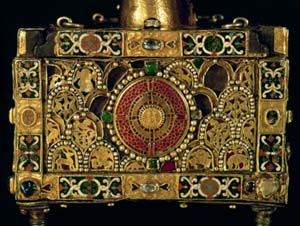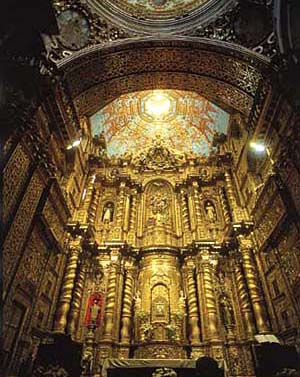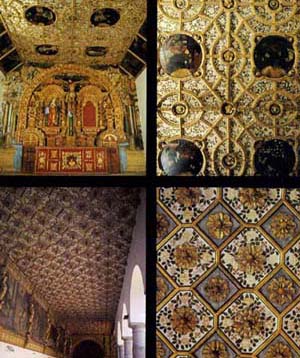 |
Art & Architecture
Ecuador, a Nation that Is a Reliquary
Patricio Padilla, Ecuador
A reliquary by definition is meant to guard something very precious, generally something that is dear and cherished. According to a tradition that dates from the Christianity of the Catacombs, it was used to hold small fragments of the bones or vestments of Martyrs and Saints, a pious custom that brings blessings and protection on those who possess them.

A 10th century reliquary for a relic of St. Andrew |
There was always a stimulus to improve, enrich and enhance the reliquaries that house these precious relics. Through the course of time, they came to be made with precious materials and embellished with jewels so they might be worthy to hold such precious relics. Such was the case of the rich and exquisite medieval reliquaries destined for the veneration of the Saints and, ultimately, the glory of the God.
Once Prof. Plinio Corrêa de Oliveira compared Ecuador to a reliquary. Why? Because even though Ecuador is a small country, it nonetheless counts a large number of Venerables, Blessed and Saints, as well as a multitude of sanctuaries and statues of Our Lord Jesus Christ, the Saints, and especially the Blessed Virgin. Throughout the centuries, innumerable miracles have been worked in this small country for an untold number of persons.

Above, the interior of the Jesuit Church in Quito's colonial plaza is gilded with gold. Below, the rich detail in the stucco ceiling of St. Augustine chapter house
 |
The capital of this nation shines like a special star in this firmament. Quito, which is perhaps the best preserved historical city center in Hispanic America, displays an essentially religious architectural ensemble. In the small nascent city of colonial times, monasteries, convents and churches abounded - so much so that one could be found at any corner.
In Quito one finds the churches of St. Francis, St. Dominic, the Jesuits, the Conception and the High Church and Low Church of the Carmelites. There are yet more – the churches of San Diego, the Collect, St. Augustine, Our Lady of Mercies, St. Barbara, and St. Blaise. And then, the Tabernacle Chapel, the Cathedral, the Chapel of the Theft. Each one is home to at least one miraculous statue or is connected with some miracle-working Blessed or Saint.
Most of these marvels occurred in the 16th and 17th centuries, an epoch when the Catholic Faith brought by the Spanish nobles and religious mixed most opportunely with the indigenous culture. In this way, it created our particular type of Christian Civilization, which soon reached its most splendid expression. It was this grand past that molded Quito’s history.
God also blessed this predestined country with an ensemble of natural riches that boast a contrast and variety that raise the admiration of all who visit. In a short distance one can leave a temperate valley and find himself at the foot of snow-capped mountains and volcanos; in another direction he finds himself on one of Ecuador’s beautiful beaches.
The adjective of Nation-Reliquary used by Prof. Plinio Corrêa de Oliveira to define Ecuador is well chosen. It also reveals the vocation this country has in the plans of God. Despite the current of pagan hedonism that is invading the country, in the depths of the soul of every Ecuadorian a religious spirit still resides. It is sad to note, however, that despite this spiritually grandiose past, its traditions and values are little by little being lost.
We have confidence and pray that at a given moment Ecuador will turn its gaze back toward that period when so much glory was given to God. Based on that grand past, may it forge a better future grounded on the sound foundation of Catholic principles.

Posted October 31, 2008

Related Topics of Interest
 Questions about Our Lady of Good Success Questions about Our Lady of Good Success
 Prophecies of Our Lady of Good Success and Our Lady of Fatima Prophecies of Our Lady of Good Success and Our Lady of Fatima
 Clash of Gothic and Cartesian Mentalities Clash of Gothic and Cartesian Mentalities
 St. Peter & the Vatican Exhibit: Marvelous Continuity, Shocking Change St. Peter & the Vatican Exhibit: Marvelous Continuity, Shocking Change
 Eric Gill: A Precursor of Vatican II Eric Gill: A Precursor of Vatican II
 The Scandalous New Look of Christ The Scandalous New Look of Christ
 Revolution and Counter-Revolution in the Tendencies, Ideas, and Facts Revolution and Counter-Revolution in the Tendencies, Ideas, and Facts

|
Art & Architecture | Hot Topics | Home | Books | CDs | Search | Contact Us | Donate

© 2002-
Tradition in Action, Inc. All Rights Reserved
|
 |
|